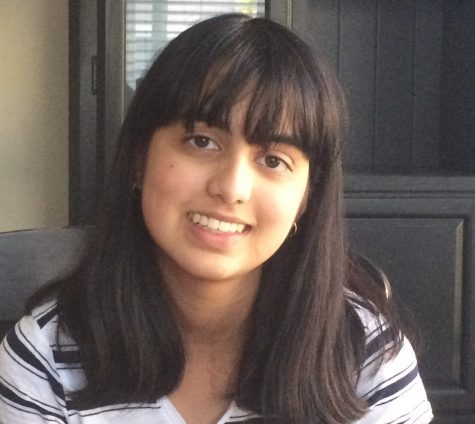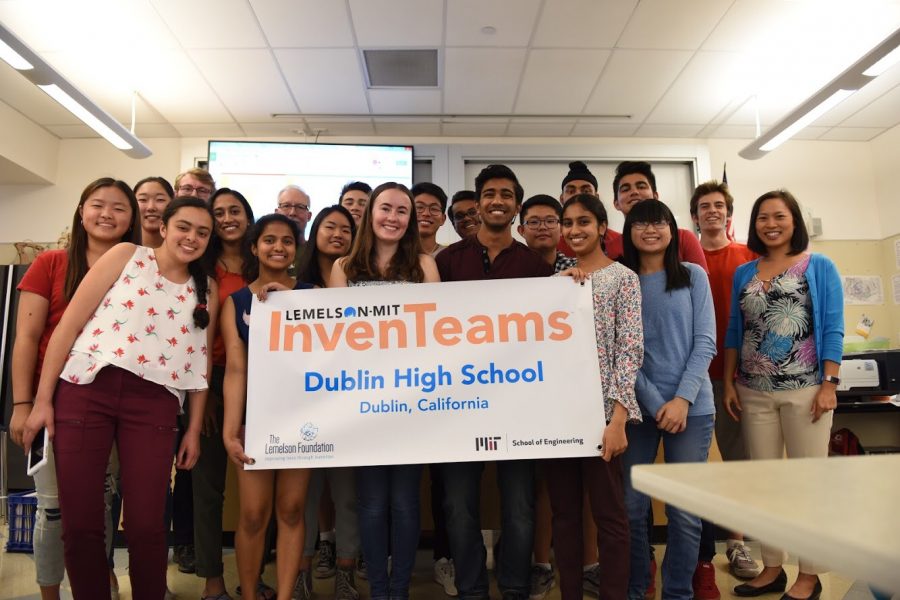Dublin High InvenTeam Wins Lemelson-MIT Grant and Is On the Road to Cambridge
The Dublin High School InvenTeam was recently awarded a $9,000 grant from the Lemelson-MIT program to develop SpORT, an assistive technology device that will allow students with disabilities to participate in basketball and soccer events during the annual Tri-Valley Special Olympics. The team consists of a group of junior and senior students from the DHS Engineering and Design Academy, advised by academy coordinator Eugene Chou.
I recently had the chance to catch up with the project leads after school, as the team was excitedly preparing for an upcoming visit from an MIT representative.
How did the idea to start this team and create an assistive technology device, SpORT, come about?
Gagan Thapar: This is the first time that Dublin High has had an MIT InvenTeam, or even participated in the competition. Dublin High hosts the Tri-Valley Special Olympics competition, so our advisor, Ms. Chou, linked the two together: the Lemelson-MIT program, as well as Special Olympics. Dublin High Gael Force Robotics had already done a project which helped with Special Olympics basketball and soccer. We decided to build upon it and make it into a full-fledged machine.
Jeffrey Cho: As a Gael Force Robotics team member, I can say our machine didn’t really have a concrete design. The machine needed to work with both soccer and basketball for Special Education students. Due to the time constraint of 2 weeks, we ended up building a quick machine with some parts that we already had. Of course, it was hard to preserve, so we’re trying to rebuild it.
How did you learn about the Lemelson-MIT grant?
Ashley Chon: A member of the DPIE Board introduced the competition to us and proposed that we go for the grant.
Eugenia Gavrilova: Ms. Chou submitted the idea to Lemelson-MIT. The competition had three stages. First, teams nationwide submitted their ideas, with no prototyping, designs, or modeling required.Out of these teams, 35 were chosen to create a design and document it, planning out how they would build their product if they were to win the grant. Finally, out of the 35 teams, 15 were chosen to win up to a $10,000 grant to actually build their project and present it at EurekaFest in Cambridge, MA in June. We are using the grant money to build a better version of the assistive tech created by Robotics.
What kind of background research did you conduct to get a better understanding of your target audience?
Eugenia: We had to cover multiple categories. We had to research prototypes that already exist: that are filed in the United States, so that we weren’t infringing on other people’s intellectual property. We also had to research the costs of the materials so that we could generate an initial budget. The grant is a maximum of $10,000 — so we had to get an idea of how much money we would need if we were to actually build this device. I think it helped because it forced us to plan more beforehand, instead of just taking the grant and running with it.
Describe SpORT. What makes it unique?
Jeffrey: SpORT stands for Special Olympics Robotic Thrower. First, a supervisor selects one of the three levels of difficulty based on each student’s capabilities. This restricts the machine’s degree of freedom.
Gagan: Next, the student drops a ball into the machine, and it rolls down through a “donut”-shaped compartment. The two flywheels compress the ball, creating more surface contact with it and increasing its initial velocity. The student will use the directional pad buttons to aim and launch the ball. It will be launched into a basketball hoop at the set degree of the mechanism, or launched horizontally for soccer towards three nets.
Jeffrey: The machine has pan and tilt motions, so it can move 90 degrees up, down, left, and right.
Gagan: The user interface screen displays what the machine is going to do in real-time. So if you press a left button, for example, the screen will show the machine turning left, with a trajectory line to where it’s going to launch either the basketball or the soccer ball. This is a really big part of our design, and makes it unique.
I understand that you have made your design specifications open-source. Why did you decide to do this?
Saahil Shangle: Because the goal of our project was to improve what is being offered to the Special Olympics community as a whole. This includes not only our local community, but also Special Ed students across the US and around the world. We’re not here to make a profit or market a business… we’re making a social impact. We’re not going to collect any royalties or file a patent. By making our device’s design open-source, we’re ensuring that everyone understands how it works and how to use it.
Describe the project timeline. When and where will you begin building the actual device?
Joanne Baek: We’ll definitely start building soon. By November, we should be done constructing our flywheel prototype, and begin testing it. We should be done ordering all the parts before February.
Eugenia: We’re waiting for the funds before we start building.
Jeffrey: Our prototype is going to be built here at Dublin High because we have access to our engineering room, which includes laser cutters, 3D printing, and a drill press… so we have all the resources here to build the prototype. But when it comes to milling metals and more durable materials, we have to outsource it. The current plan is to get it done at TechShop San Jose. Las Positas College has also offered the use of their welding facilities.
Since this device is specifically catered to students with disabilities, what are some of the extra safety precautions you have taken while designing SpORT?
Jeffrey: There will be a key that will only allow a supervisor to activate the machine. We also have a clear plastic casing that encloses the machine, which prevents any contact injuries.
Eugenia: We’ve also been talking to Eric Hamilton, who organizes the Special Olympics events that Dublin High hosts. We’re consulting with him about sound effects and lighting, because we don’t want to put anything in our machine that students with special needs may be sensitive to.
Saahil: Also, we designed the machine so that students have enough space to roll their wheelchair underneath it. We envisioned how a student would come up to the device and be able to comfortably use it so that it’s safe.
What would you describe as the overall goal of this project?
Eugenia: It’s an opportunity for us to give back to our community, using our technical knowledge and soft skills. In fact, the purpose of the Engineering and Design Academy is to create projects like this that have an impact. I think it’s awesome that we have the chance to undertake something like this so early!
Saahil: For me personally, I really can’t wait to see us finish this project. My biggest satisfaction would be seeing a smile from a kid who’s never played soccer or basketball up until now, after using SpORT. Seeing that kid’s satisfaction of being able to engage and participate in something so exciting with their peers would be very special to me.
Given the time and dedication required for the project, why did you volunteer to become a part of this team?
Jeffrey: The determination of this team, as well as the dedication of our mentors, is what makes me enjoy being a part of it.
Joanne: After Saahil explained to me what the purpose of this team was, I realized that it is a great opportunity to serve our community using our skills. The cause was really meaningful and that’s why I’m here.
Saahil: When I joined the team, I did not realize how much of work it entailed. Late-night calls till 4 in the morning, sometimes! But this project is so meaningful and I just keep that in mind, especially after we visited the Special Ed classes at Dublin Elementary School. Picturing those kids, how they’re going to use this, how many lives could change… It’s great to have an impact this big!
Eugenia: We’re creating a physical device to specifically help Special Ed students in the Tri-Valley play sports that they’ve never had the opportunity to experience before. Just being able to do something that I can feel the impact of is what most attracted me to the project.
Ashley: It was a way for us to directly use our skills that we learned from our Engineering classes to make a difference in the community.
Gagan: A lot of us joined because we were asked to, but we stuck through because we wanted to. We all wanted to give back to the community. This project is all about community service. We’ve been given so much, it’s our turn to give back.
How can the community support this project or get involved?
Eugenia: Please donate! Visit dhsinvent.com/donate. This donation fund goes through DPIE. All of the funds that we raise on our website come directly to us. Also, donations are tax-deductible.
We are hosting a mid-year review, which will be sometime in February. You can also donate then and learn more about our project and our progress. We’re also planning many restaurant fundraisers, so please attend. We’re going to set up a newsletter, please subscribe to it!
Saahil: Follow us on social media: @dhsinvent on Instagram and Twitter. If you see our posts online, please retweet them. The more publicity, the more contributions we can get and just more support overall.
Joanne: We need to raise $20,000 in additional budget. $9000 is enough just for the prototype.
Saahil: We’re also looking for sponsors from any local businesses.
Jeffery: Any donations of materials from companies that manufacture or sell plastics or building materials would be great!
Eugenia: Even though we won a grant of $9000, we still need to cover our travel costs to EurekaFest to present our project in Cambridge. We also need money for additional prototyping costs so that our machine turns out the best it can be. $9000 does seem like a lot, but with a project this big that affects so many people… there’s always room for more to make our project better.
The project leads for 2017-2018 DHS InvenTeam:
Senior Saahil Shangle, Administrative Lead
Senior Eugenia Gavrilova, PR/Communications Lead
Senior Jeffrey Cho, Electrical Lead
Senior Gagan Thapar, Technical/Mechanical Lead
Senior Joanne Baek, Co-Finance Lead
Junior Ashley Chon, Co-Finance Lead
Senior Jaiveer Singh, Software Lead
Your donation will support the student journalists of Dublin High School. Your contribution will allow us to purchase equipment and cover our annual website hosting costs.

Neha Harpanhalli is a junior at Dublin High School and the Senior Student Life Editor for the Dublin Shield. She is extremely passionate about reading...



































